check oil TOYOTA FJ CRUISER 2013 1.G Owners Manual
[x] Cancel search | Manufacturer: TOYOTA, Model Year: 2013, Model line: FJ CRUISER, Model: TOYOTA FJ CRUISER 2013 1.GPages: 568, PDF Size: 9.49 MB
Page 128 of 568

128 2-1. Driving procedures
NOTICE
■When encountering flooded roads
Do not drive on a road that has flooded after heavy rain etc. Doing so may
cause the following serious damage to the vehicle.
●Engine stalling
● Short in electrical components
● Engine damage caused by water immersion
In the event that you drive on a flooded road and the vehicle is flooded, be
sure to have your Toyota dealer check the following.
● Brake function
● Changes in quantity and quality of oil and fluid used for the engine, trans-
mission, transfer (4WD models), differentials, etc.
● Lubricant condition for the propeller shaft, bearings and suspension joints
(where possible) and the function of all joints, bearings, etc.
Page 205 of 568

205
2-5. Driving information
2
When driving
NOTICE
■
To prevent the water damage
●Take all necessary safety measures to ensure that water damage to the
engine or other components does not occur.
● Water entering the engine air intake will cause severe engine damage.
● Water entering the automatic transmission will cause deterioration in shift
quality, locking up of your transmission accompanied by vibration, and ulti-
mately damage.
● Water can wash the grease from wheel bearings, causing rusting and pre-
mature failure, and may also enter the differentials, transmission and
transfer case, reducing the gear oil’s lubricating qualities.
■ When you drive through water
If driving through water, such as when crossing shallow streams, first check
the depth of the water and the bottom of the river bed for firmness. Drive
slowly and avoid deep water.
■ Inspection after off-road driving
●Sand and mud that has accumulat ed in brake drums and around brake
discs may affect braking efficiency and may damage brake system compo-
nents.
● Always perform a maintenance inspection after each day of off-road driv-
ing that has taken you through rough terrain, sand, mud, or water. For
scheduled maintenance information, refer to the “Scheduled Maintenance
Guide” or “Owner’s Manual Supplement”.
Page 211 of 568
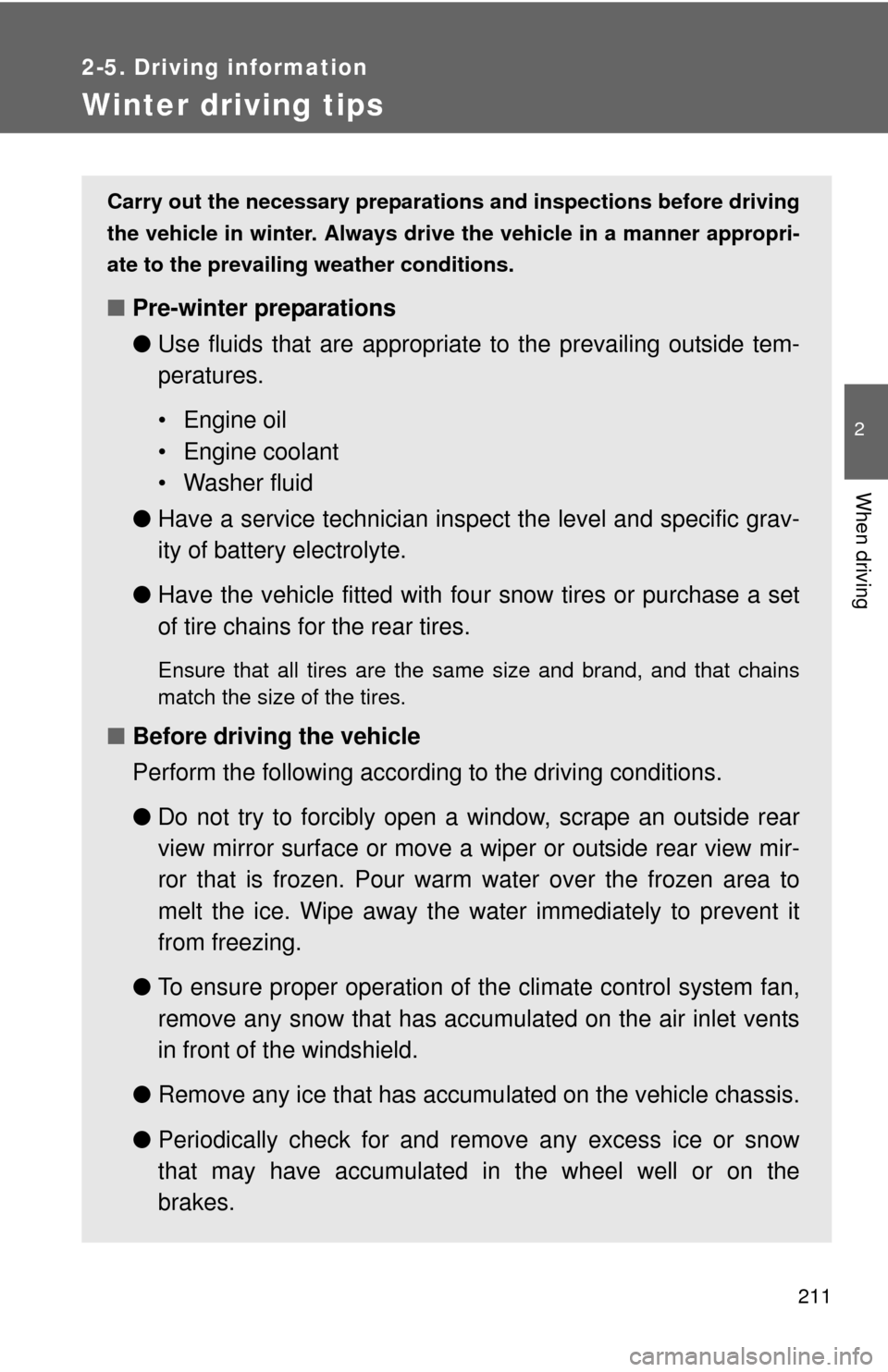
211
2-5. Driving information
2
When driving
Winter driving tips
Carry out the necessary preparations and inspections before driving
the vehicle in winter. Always drive the vehicle in a manner appropri-
ate to the prevailing weather conditions.
■ Pre-winter preparations
●Use fluids that are appropriate to the prevailing outside tem-
peratures.
• Engine oil
• Engine coolant
• Washer fluid
● Have a service technician inspect the level and specific grav-
ity of battery electrolyte.
● Have the vehicle fitted with four snow tires or purchase a set
of tire chains for the rear tires.
Ensure that all tires are the same size and brand, and that chains
match the size of the tires.
■Before driving the vehicle
Perform the following according to the driving conditions.
●Do not try to forcibly open a window, scrape an outside rear
view mirror surface or move a wiper or outside rear view mir-
ror that is frozen. Pour warm water over the frozen area to
melt the ice. Wipe away the water immediately to prevent it
from freezing.
● To ensure proper operation of th e climate control system fan,
remove any snow that has accumulated on the air inlet vents
in front of the windshield.
● Remove any ice that has accumu lated on the vehicle chassis.
● Periodically check for and remove any excess ice or snow
that may have accumulated in the wheel well or on the
brakes.
Page 400 of 568

400
4-2. Maintenance
General maintenance
Engine compartment
ItemsCheck points
Battery Maintenance-free. ( P. 418)
Brake fluid At the correct level? ( P. 415)
Engine coolant At the correct level? ( P. 413)
Engine oil At the correct level? ( P. 410)
Exhaust system No fumes or strange sounds?
Power steering fluid At the correct level? ( P. 417)
Radiator/condenser/hoses Not blocked with foreign matter?
(P. 415)
Washer fluid At the correct level? (P. 421)
Listed below are the general maintenance items that should be per-
formed at the intervals specified in the “Scheduled Maintenance
Guide” or “Owner’s Manual Supp lement”. It is recommended that
any problem you notice should be brought to the attention of your
Toyota dealer or qualified service shop for advice.
Page 410 of 568
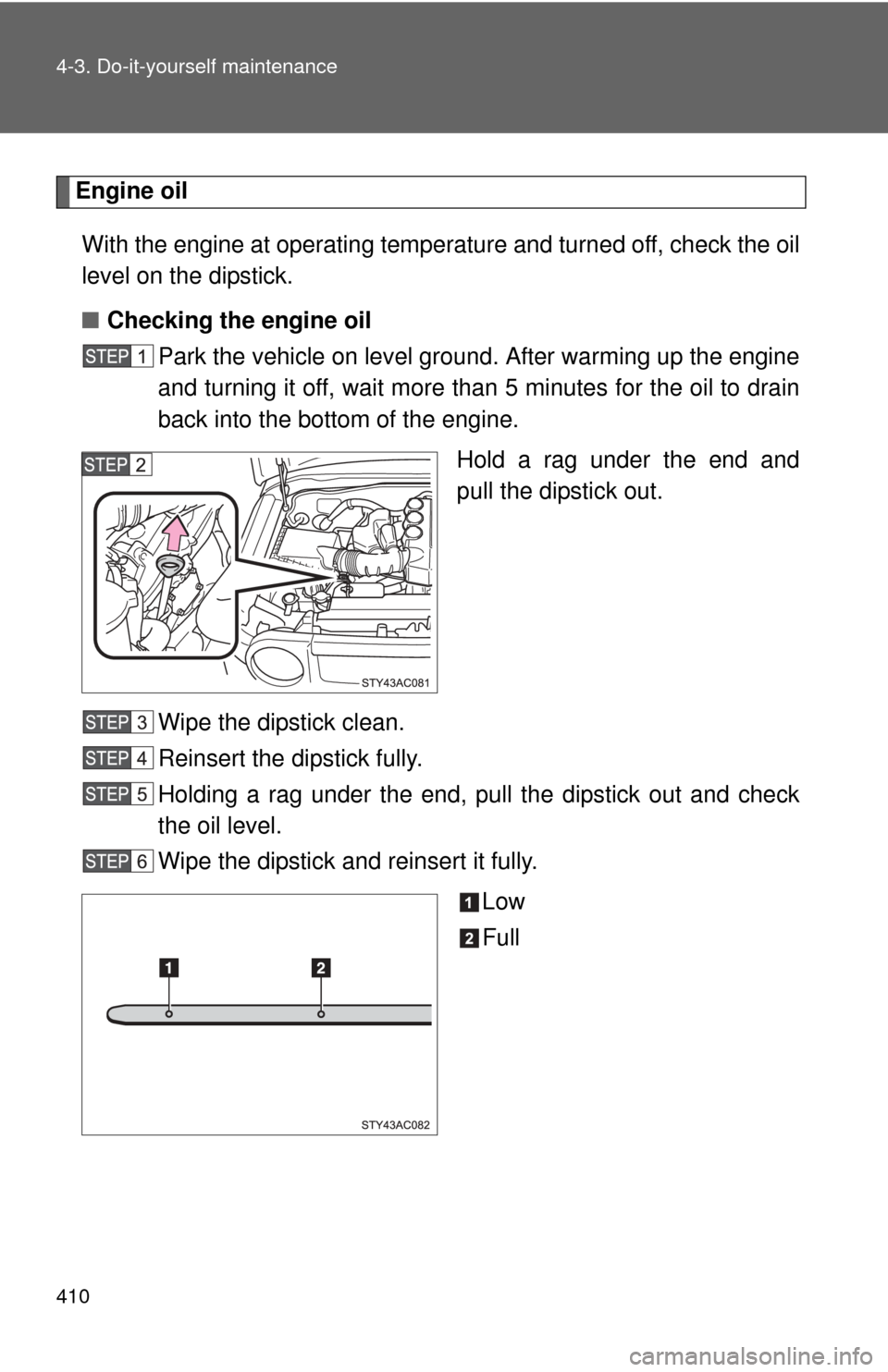
410 4-3. Do-it-yourself maintenance
Engine oilWith the engine at operating temperature and turned off, check the oil
level on the dipstick.
■ Checking the engine oil
Park the vehicle on level ground. After warming up the engine
and turning it off, wait more than 5 minutes for the oil to drain
back into the bottom of the engine.
Hold a rag under the end and
pull the dipstick out.
Wipe the dipstick clean.
Reinsert the dipstick fully.
Holding a rag under the end, pull the dipstick out and check
the oil level.
Wipe the dipstick and reinsert it fully. Low
Full
Page 411 of 568
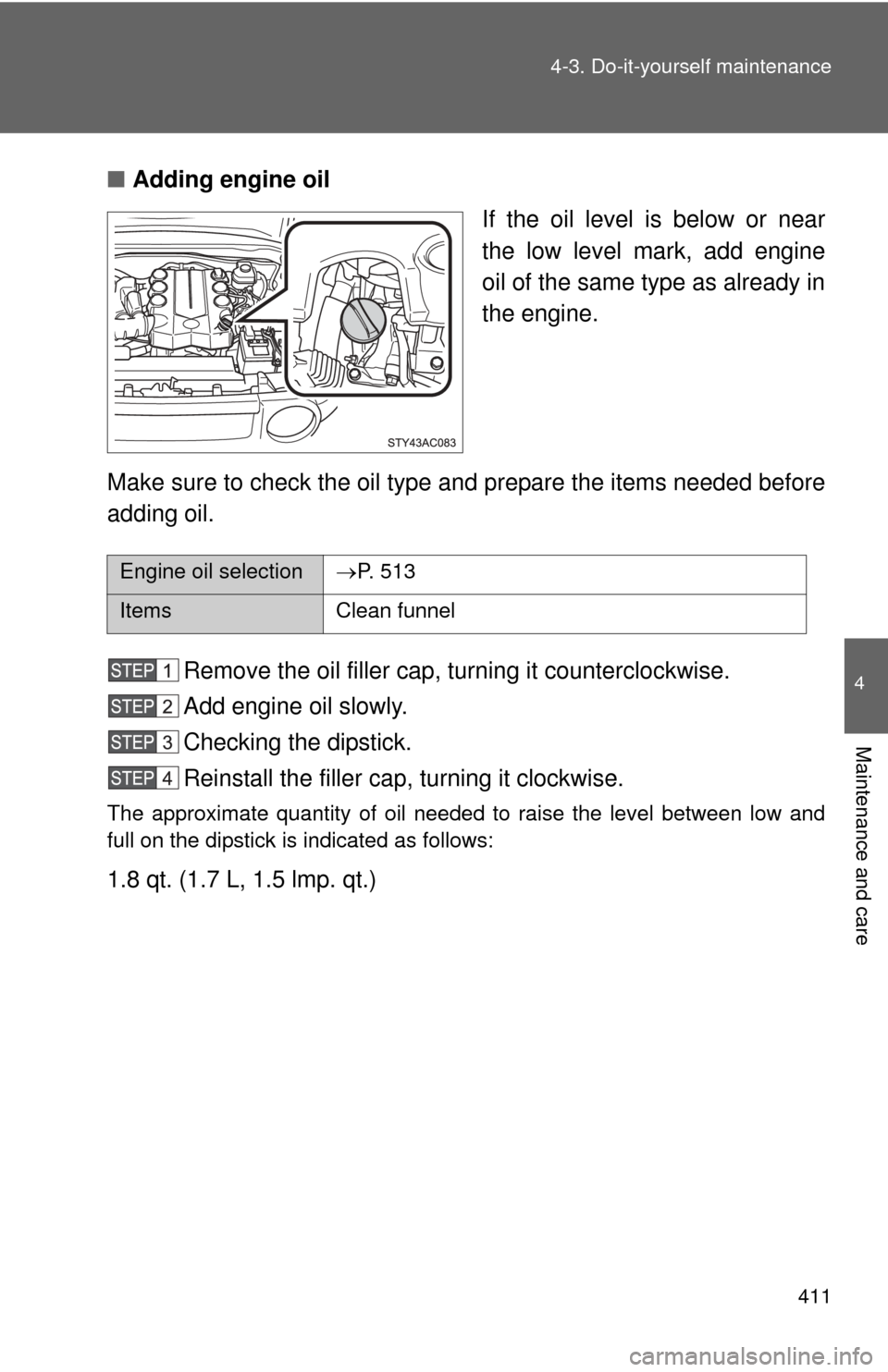
411
4-3. Do-it-yourself maintenance
4
Maintenance and care
■
Adding engine oil
If the oil level is below or near
the low level mark, add engine
oil of the same type as already in
the engine.
Make sure to check the oil type and prepare the items needed before
adding oil. Remove the oil filler cap, turning it counterclockwise.
Add engine oil slowly.
Checking the dipstick.
Reinstall the filler cap, turning it clockwise.
The approximate quantity of oil needed to raise the level between low and
full on the dipstick is indicated as follows:
1.8 qt. (1.7 L, 1.5 lmp. qt.)
Engine oil selection P. 513
ItemsClean funnel
Page 413 of 568

413
4-3. Do-it-yourself maintenance
4
Maintenance and care
Engine coolant
The coolant level is satisfactory if it is between the F (Full) and L
(Low) lines on the reservoir when the engine is cold. Reservoir cap
F (Full)
L (Low)
If the level is on or below the L
line, add coolant up to the F line.
NOTICE
■To prevent serious engine damage
Check the oil level on regular basis.
■ When replacing the engine oil
●Be careful not to spill engine oil on the vehicle components.
● Avoid overfilling, as the engine could be damaged.
● Check the oil level on the dipstick every time you refill the vehicle.
● Be sure the engine oil filler cap is properly tightened.
Page 473 of 568
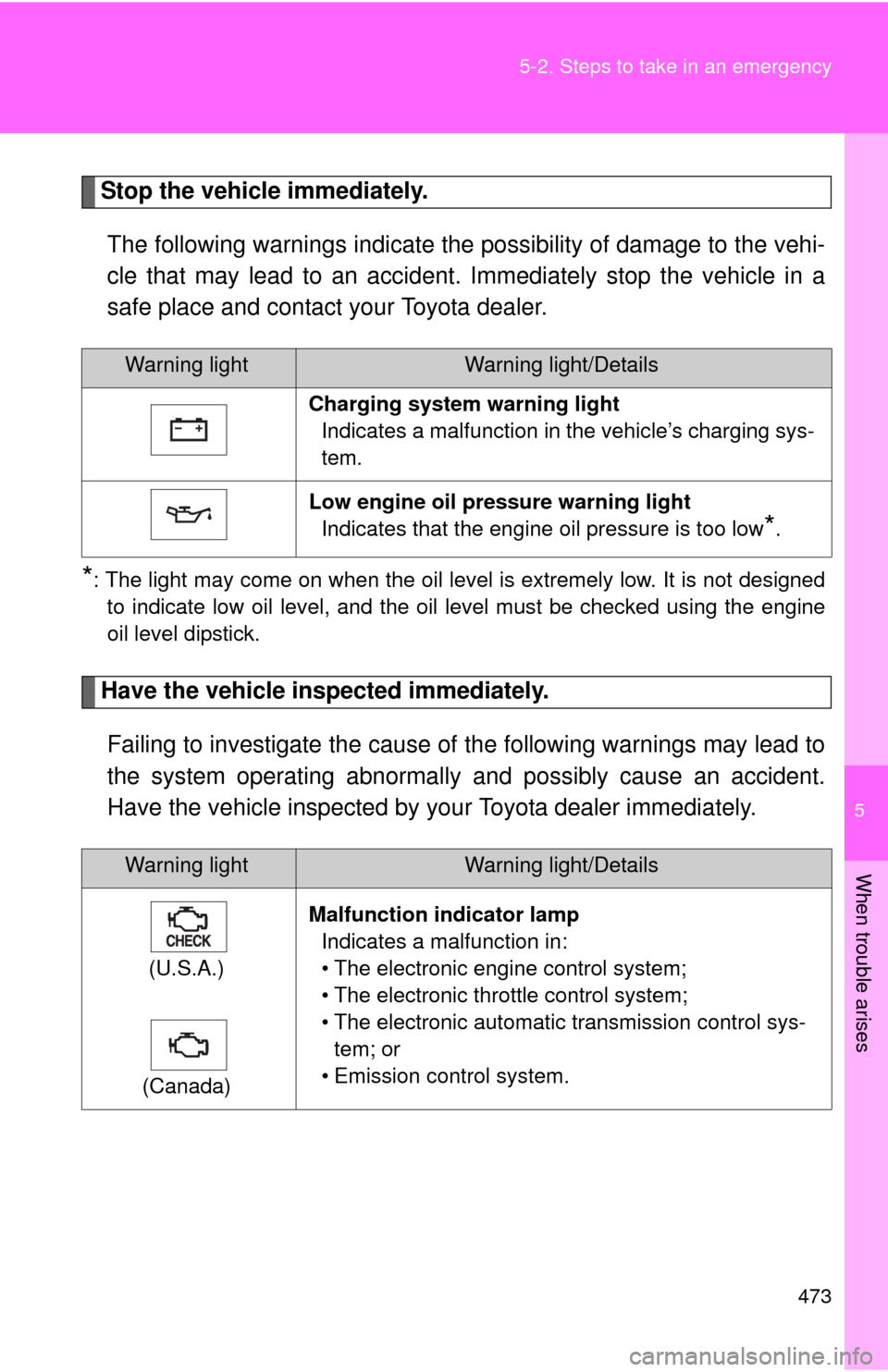
5
When trouble arises
473
5-2. Steps to take in an emergency
Stop the vehicle immediately.
The following warnings indicate the possibility of damage to the vehi-
cle that may lead to an accident. Immediately stop the vehicle in a
safe place and contact your Toyota dealer.
*: The light may come on when the oil level is extremely low. It is not designed to indicate low oil level, and the oil level must be checked using the engine
oil level dipstick.
Have the vehicle inspected immediately.
Failing to investigate the cause of the following warnings may lead to
the system operating abnormally and possibly cause an accident.
Have the vehicle inspected by your Toyota dealer immediately.
Warning lightWarning light/Details
Charging system warning light Indicates a malfunction in the vehicle’s charging sys-
tem.
Low engine oil pressure warning light Indicates that the engine oil pressure is too low
*.
Warning lightWarning light/Details
(U.S.A.)
(Canada) Malfunction indicator lamp
Indicates a malfunction in:
• The electronic engine control system;
• The electronic throttle control system;
• The electronic automatic transmission control sys-tem; or
• Emission control system.
Page 513 of 568

513
6-1. Specifications
6
Vehicle specifications
Lubrication system
*: The engine oil capacity is a reference quantity to be used when
exchanging. Warm up and turn off the engine, wait more than 5 minutes,
and check the oil level on the dipstick.
■Engine oil selection
“Toyota Genuine Motor Oil” is used in your Toyota vehicle. Use
Toyota approved “Toyota Genuine Motor Oil” or equivalent to satisfy
the following grade and viscosity.
Oil grade: ILSAC GF-5 multigrade engine oil
Recommended viscosity: SAE 0W-20
SAE 0W-20 is the best choice for
good fuel economy and good
starting in cold weather.
If SAE 0W-20 is not available,
SAE 5W-20 oil may be used.
However, it must be replaced
with SAE 0W-20 at the next oil
change.
Oil viscosity (0W-20 is explained here as an example):
●The 0W in 0W-20 indicates the characteristic of the oil which allows cold
startability. Oils with a lower value before the W allow for easier starting of
the engine in cold weather.
● The 20 in 0W-20 indicates the viscosity characteristic of the oil when the
oil is at high temperature. An oil with a higher viscosity (one with a higher
value) may be better suited if the vehicle is operated at high speeds, or
under extreme load conditions.
Oil capacity
(Drain and refill
- reference
*)
With filter
Without filter 6.4 qt. (6.1 L, 5.4 Imp.qt.)
6.0 qt. (5.7 L, 5.0 Imp.qt.)
Outside temperature
Page 558 of 568
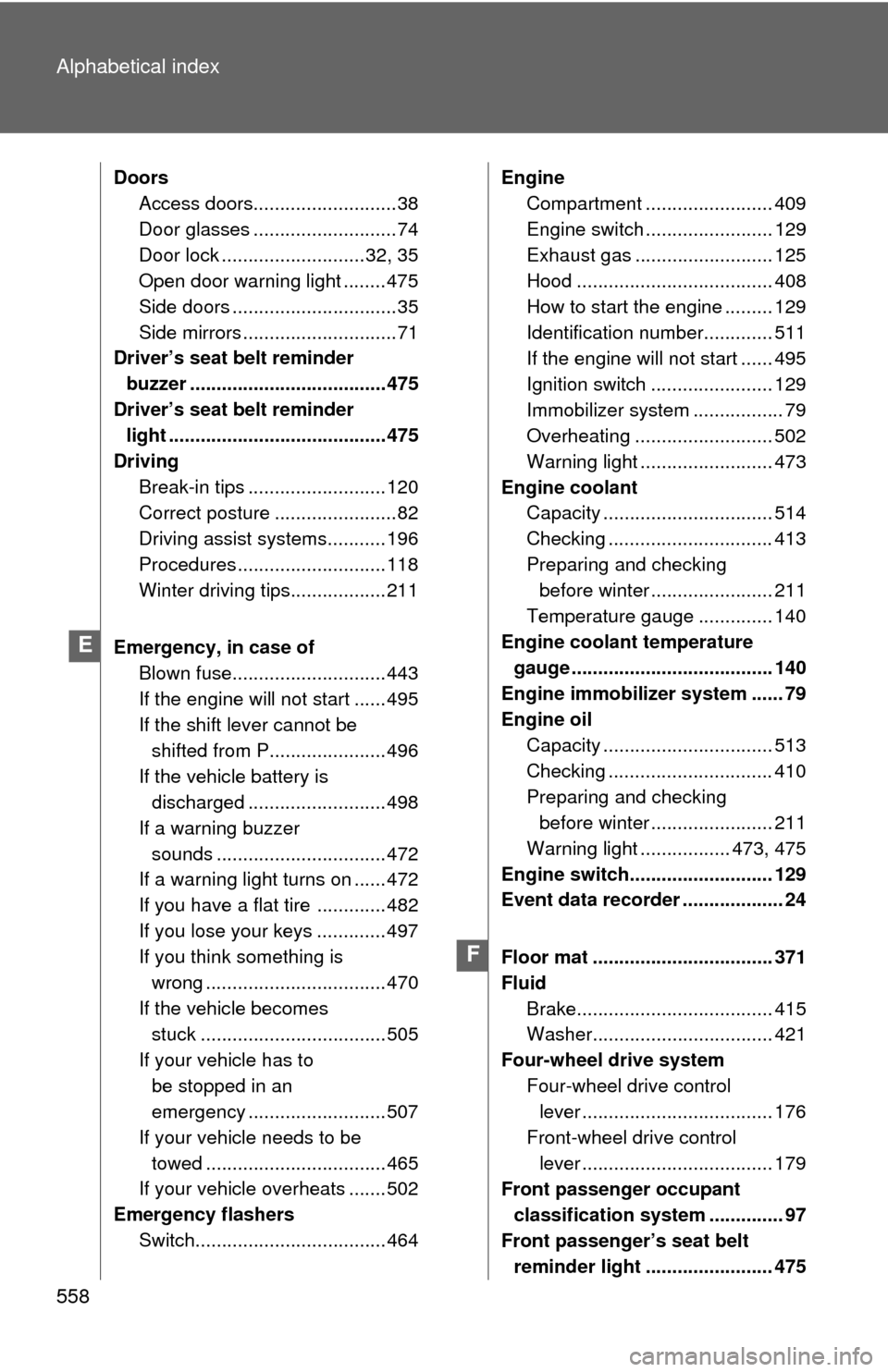
558 Alphabetical index
DoorsAccess doors...........................38
Door glasses ...........................74
Door lock ...........................32, 35
Open door warning light ........ 475
Side doors ...............................35
Side mirrors .............................71
Driver’s seat belt reminder
buzzer ..................................... 475
Driver’s seat belt reminder light ......................................... 475
Driving Break-in tips .......................... 120
Correct posture .......................82
Driving assist systems........... 196
Procedures ............................ 118
Winter driving tips.................. 211
Emergency, in case of Blown fuse............................. 443
If the engine will not start ...... 495
If the shift lever cannot be shifted from P...................... 496
If the vehicle battery is discharged .......................... 498
If a warning buzzer sounds ................................ 472
If a warning light turns on ...... 472
If you have a flat tire ............. 482
If you lose your keys ............. 497
If you think something is
wrong .................................. 470
If the vehicle becomes stuck ................................... 505
If your vehicle has to be stopped in an
emergency .......................... 507
If your vehicle needs to be towed .................................. 465
If your vehicle overheats ....... 502
Emergency flashers Switch.................................... 464 Engine
Compartment ........................ 409
Engine switch ........................ 129
Exhaust gas .......................... 125
Hood ..................................... 408
How to start the engine ......... 129
Identification number............. 511
If the engine will not start ...... 495
Ignition switch ....................... 129
Immobilizer system ................. 79
Overheating .......................... 502
Warning light ......................... 473
Engine coolant Capacity ................................ 514
Checking ............................... 413
Preparing and checking before winter ....................... 211
Temperature gauge .............. 140
Engine coolan t temperature
gauge ...................................... 140
Engine immobilizer system ...... 79
Engine oil Capacity ................................ 513
Checking ............................... 410
Preparing and checking before winter ....................... 211
Warning light ................. 473, 475
Engine switch........................... 129
Event data recorder ................... 24
Floor mat .................................. 371
Fluid Brake..................................... 415
Washer.................................. 421
Four-wheel drive system Four-wheel drive control lever .................................... 176
Front-wheel drive control lever .................................... 179
Front passenger occupant
classification system .............. 97
Front passenger’s seat belt reminder light ........................ 475
E
F